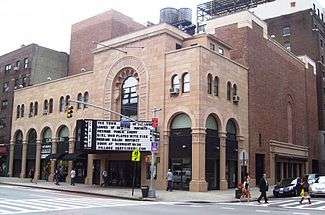Yiddish Art Theatre

The Yiddish Art Theatre was a New York Yiddish theatre company of the 20th century.
The organization was founded in 1918 by actor and impresario Maurice Schwartz, to present serious Yiddish drama and works from world literature in Yiddish.[1][2]
At its 1918 founding, the Yiddish Art Theatre was housed at the Irving Place Theatre in Union Square, Manhattan.[3] In 1919 the company moved to the Garden Theatre at Madison Avenue and 27th Street, where they remained on and off for six years, presenting works by playwrights including Leonid Andreyev, S. Ansky, Sholem Aleichem, Maxim Gorky, Gerhart Hauptmann, Peretz Hirschbein, David Pinski, Arthur Schnitzler, George Bernard Shaw and Oscar Wilde.
The Garden Theatre was part of the second Madison Square Garden complex, and in the face of plans to demolish the complex the Yiddish Art Theatre moved to the Nora Bayes Theater on West 44th Street in 1925. Their tenancy there was brief, as the next year the Yiddish Art Theatre moved to its own purpose-built theatre: the Louis N. Jaffe Theater, a Moorish Revival theatre on Second Avenue in the heart of the Yiddish Theatre District which Brooklyn developer and prominent Jewish community leader Louis Jaffe had built in 1925–1926 to house the company.[1]
Shows produced by Maurice Schwartz at this new venue included a production of "Yoshe Kalb" which ran for 300 performances.[4] The Yiddish Art Theatre operated for 40 years after its founding, performing classics of Yiddish, European and English theatre, ranging from works by Sholem Aleichem to William Shakespeare.
References
- 1 2 James Murray and Karla Murray (January 27, 2017). "The Urban Lens: Inside the Village East Cinema, one of NY's last surviving 'Yiddish Rialto' theaters". 6sqft. Retrieved March 5, 2017.
- ↑ Amanda Seigel (March 18, 2014). "The Yiddish Broadway and Beyond". New York Public Library. Retrieved March 5, 2017.
- ↑ "German Drama to Move; Irving Place Theatre Will Be Yiddish Playhouse". New York Times. February 14, 1918. Retrieved March 5, 2017.
- ↑ Annie Cofone (June 8, 2012). "Strolling Back Into the Golden Age of Yiddish Theater". The Local – East Village. Retrieved March 5, 2017.